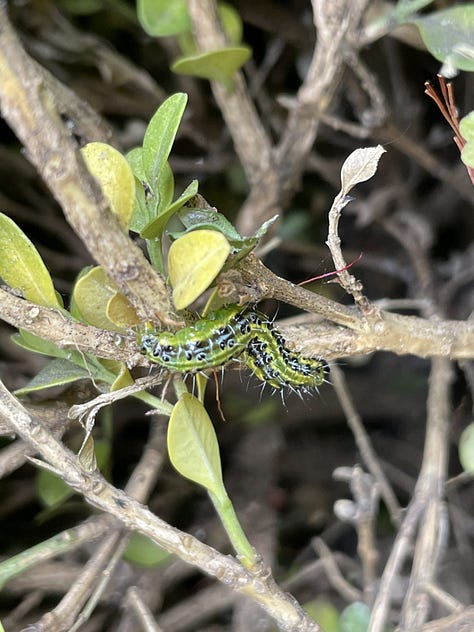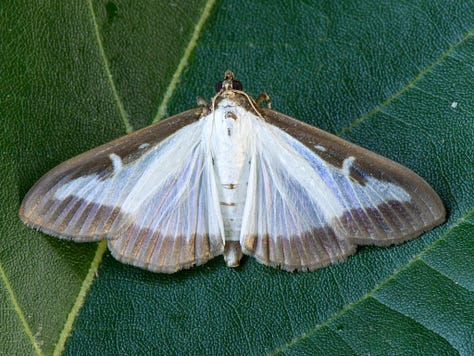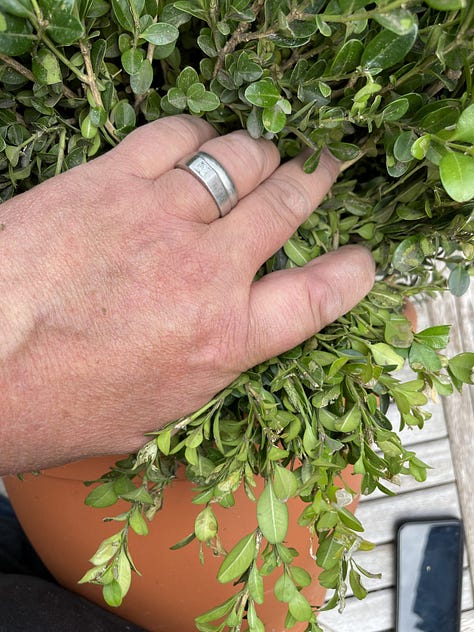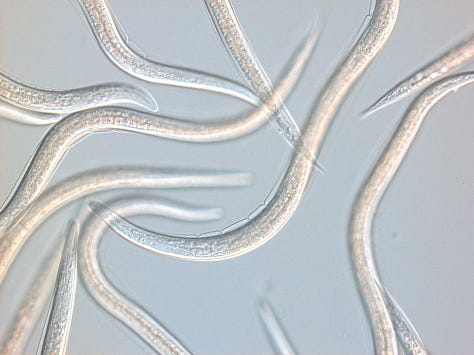How I Dealt with Box Blight & Box Moth Caterpillar
…but is it time to throw in the towel and look at the alternatives?
In today’s column I’m telling you all about how I’ve dealt with Box Blight and the Box Moth Caterpillar to some success in my last few gardens. This Wednesday I have a follow-up guest post written by the lovely people at Architectural Plants, in which they will be showing you the wonderful alternatives to Box.
I’ve always admired formal topiary, it appeals to my sense of order. There truly is nothing better than a well-trimmed bush in my opinion. I’ve used Box in just about every garden I’ve designed over the years. In our Surrey garden, which we sold in 2020, I created a box border with over 40 different sized balls, which undulated to look like a cloud. One of my first blog posts ever back in 2018 was all about the lush green balls of joy that us British folk seem to love so much. But, pesky fungi and sneaky leaf-munching critters have become the bane of my life. Just when I think I’ve won I spy a bald patch on one of my balls and before you know it I’m fire-fighting again. It’s exhausting!
My first battle with the blight started in 2018 in our Surrey garden. Unbeknownst to me, the mass of densely-planted Box balls was exactly the right environment for the killer disease. The RHS advice at the time (it has since changed) was to dig everything up and burn the lot! There was no way on god’s earth I was doing that, so I set about trying to find my own cure. I found a Box feed called Top Buxus – Health Mix. It’s widely used now, but back then hardly anyone had heard of it. Health Mix is a strong fertiliser with copper mixed in, which burns the spores of the fungus.
Over half of my Box border was affected. Some of the balls had lost almost all their leaves. I decided I would cut back all the damaged plants as much as I could. I placed an old sheet around the base of each ball to catch the leaves and then removed any debris and cut leaves within the plant and on the sheet. I then burnt all the clippings, you mustn’t put them in your compost bin! After that I used the Health Mix treatment. I used one tablet per litre of water in a backpack pump spray. I waited till it was dry outside and no chance of rain, then I sprayed every ball like it was going out of style! I repeated this every two weeks until I started to see improvement.



I was distraught to the point of being reduced to tears at the thought of losing my Box border. But, they were saved after about six weeks of applying the mix and following the instructions to the letter. I then continued spraying once a fortnight throughout the summer season. I didn’t prune them for a whole year after that to give them time to recover and to allow more air to circulate. I used a liquid seaweed fertiliser as well as the mix to get them as healthy as possible. Healthy, airy plants are the key to avoiding the blight and less pruning really helps as the fungus tends to enter the plant via cuts.
When I did prune I made sure the weather was dry and there was little chance of rain. The spores of the fungus Cylindrocladium Buxicola, which cause Box blight can be spread by rain drops splashing onto any fungus that might be on the leaves of the plants and also from any spores on the ground, they live in the ground for up to six years! It’s also one of the reasons why I only water the plants from below. I have a mulch around the plants to reduce splash.
Keep all your tools clean and remember that after pruning do pick up all the clippings. Here’s the advice from Architectural Plants: “Good hygiene, surgery and medicine, work. When clipping, always have a bucket of 5% bleach solution (household bleach or Milton solution will do) and dip the tool you’re using in the bucket, regularly and count to five. The bleach will kill any spores on the tool and stop you spreading the disease. Clear up all clippings from the ground and burn them and any badly affected areas, cut out entirely. If this leaves an ugly hole (it will), it’s not half as ugly as having an expanding patch of dead plant and as nature abhors a vacuum, the plant will fill the hole with new growth before too long!”
I had planned to use Box again in our next garden, the Victorian walled lovely thing that it was. I bought two medium sized balls for the front entrance. However, within a month of being there I discovered via a neighbour that the Box Moth Caterpillar was prevalent in the area. By mid-summer I started to notice bald patches and with closer inspection, I could see it was infested with little devilish caterpillars having the most jolly of feasts.
The Box Moth Caterpillar
The lifecycle lasts about 45 days. First eggs are laid on the underside of leaves and they are the colour of young Box leaves, so very difficult to spot and if you wear glasses you’ll definitely need them! After they hatch the Box Moth caterpillars develop large black heads and spots. It takes about 2 weeks to become an adult caterpillar and they live for about 2 weeks. They form a cocoon in white webbing spun around the leaves and it takes a week for them to transform into a moth, where the cycle starts all over again, laying hundreds of eggs.



What are the signs of an infestation?
The first thing you will notice is that some of the leaves have been munched. On closer inspection you may see other leaves that have almost become a ghost of their former selves as they are nothing but a wafer thin see-through skeleton. Look more closely and you’ll start to see yellow-green caterpillars with black spots and a black head.
There will also be signs of webbing, silk strands all of over and inside the bush. The caterpillars tend to protect themselves within the webbing. You’ll see little tiny black balls too, they aren’t eggs, it’s caterpillar poo. I know, gross! Left unchecked, these little green creepy crawlies will ravage your bush and it could even die. So, don’t delay, no one wants a ravaged bush!
Insecticide or biological warfare?
The first thing some gardeners will want to do is reach for the bug killer. There are various products on the open market, such as Provanto, but almost all are dangerous to humans, pets, aquatic species and most other wildlife. Yes, it will do something to help an infestation of Box Moth Caterpillar, but it’s going to cost you a small fortune in spray as you’ll have to keep doing it over and over and I’m pretty certain it won’t eradicate the problem. It’s very hard to get in and spray the underneath of all the leaves and even if you can you will be sure to kill all sorts of other insects by using it, potentially bees too, so please, please don’t do that.
So what’s the answer?
The first thing I did was very time consuming, but worth it. Slowly and methodically go through the bush and remove any caterpillars you can see. I found over 100 of them! Either squish them or put them in a bucket of water. This will reduce the amount of immediate munching of the leaves and slow down the devastation. I then had a good comb through the bushes and removed any debris.
After that I used a product called XenTari, which is a biological insecticide containing a natural, potent strain of the microorganism Bacillus thuringiensis subspecies aizawai, which kills the box caterpillar. It is harmless to pets, humans and bees and any other animals that might eat the infected caterpillars. However, it’s not available in the UK (although you can find it online as I proved) for the average gardener yet because it’s still going through the very long and costly process of being tested and checked for safety.
The problem is it kills all moth and butterfly caterpillars if not used sparingly and only on the Box plant itself. I’m really not sure whether the average person would read and adhere to the instructions. I was extremely careful and as my two Buxus were in pots, I was able to move them away from any other plants before I used the spray. But what if you sprayed within a border? I worry about that if it eventually gets accreditation.
However, it really did work on my two quarantined Box balls. When applied at the right moment, only 3 treatments per season are necessary to keep the caterpillar pest under control. This moment can be more easily predicted by using a Box tree moth trap to monitor Box tree moth activity. When moths are trapped you can expect new caterpillars a couple of weeks later.
Be careful!
You will need to be extraordinarily careful to make sure you are not spraying any flowering plants nearby. I used a 5 litre backpack spray gun to save myself having to constantly keep pressing the gun, as it had a continuous spray mode. The backpack works by creating pressure inside the bottle using a hand pump. I also use the same backpack spray gun for when I’m applying Top Buxus Health Mix.
It does not harm important beneficial insects such as bees for pollination, insect predators, and parasites used in control of other insect pests. But, as I have said before, it can kill all forms of caterpillar, so you must make sure you only spray your Box plants and nothing else.



Up until May this year, my two Box balls have been fine. Then we moved into our barn and I discovered another infestation. I acted quickly and they are now green and lush again, but for how long and is it worth it? I certainly won’t be buying any more Buxus that’s for sure.
A safer treatment?
I have recently started looking into using natural predators for the control of the Box Caterpillar. Dragonfli.co.uk sell nematodes which kill the caterpillars. They also sell sachets which hold the eggs of over 2000 tiny parasitic wasps which, once hatched over a 2-4 week period, bore into the Box Moth Caterpillar eggs, laying their own eggs inside them, killing them in the process. I have not tried these yet, but they sound like a great, safe alternative.



…and finally
I started looking into alternatives to Box a couple of years ago, pretty much after I decided to not buy any more of the blighted plants. I found Ilex Crenata and Euonymus Japonicus, but there are so many other disease-free options now. You can find out all about them on Wednesday when I’ll be posting a piece by Architectural Plants, one of my favourite nurseries. I recently visited their site in Pulborough, England and was blown away by the options available to us there. Stay tuned!
Please do leave a heart ♥️, a restack (that’s the recycle symbol below) and/or a comment. It makes the most enormous difference and makes sure new people see this post and join our club. It only takes a second. Thank you.
This post contains a few affiliate links, where I may earn a small commission, but at no extra cost to you.






Very helpful advice. Thankyou, we lost all our box 3 years ago and now only have ilex crenata - fingers crossed they are doing well 🙌🙌
Fantastic post, JP. One close to my heart, too, as we lost every single box plant (around 200 bought as tiny plants) in my mum's garden to the dreaded boxwood caterpillar back in 2018, after trying to save them over 3 years. I used Xentari too. Honestly, unless you camp out beside the plants you are lost! If it's one or two plants, maybe, but whatever the Xentari experts say, it's a full time job. Particularly as there is so much rain. Because you have to repeat the spraying after rain. So you can see how it's a lost cause with the months and months of rain we've had just this past year. I felt bereft as the entire garden lost its definition and I had to say bye-bye to my balls.
Since 2020, I've replanted with Euonymous jap 'Jean Huges' and it's bulking up nicely. To save money any pruning I do this year ( I wanted to give them time to find their feet) I will make cuttings for new plants. There really is nothing as beautiful as box, but this Euonymous has small fresh green leaves and can be topiarised like box.
I am glad you shared the info that Xentari won't be selective to only kill one type of moth/caterpillar and that is concerning.
An excellent insight to these pesky fellas. Thank you.
Frannyx